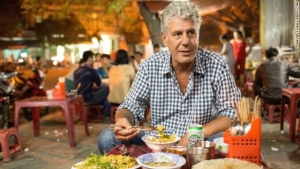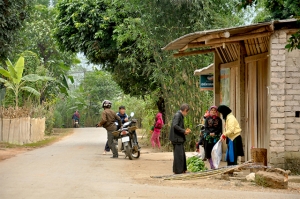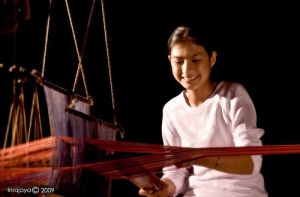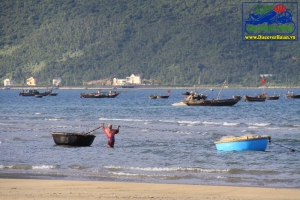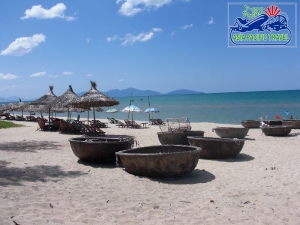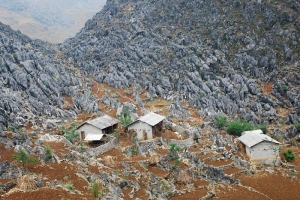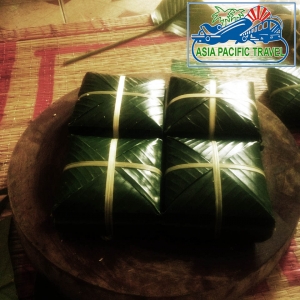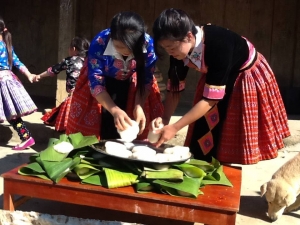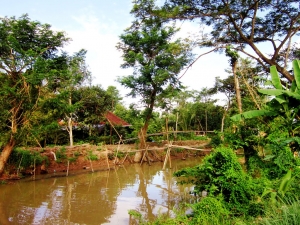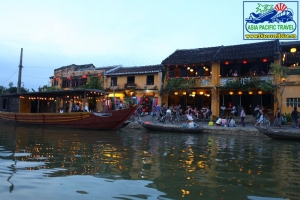
Asia Pacific Travel Team
Discover the capital's taste
Food tours are expanding in the capital city. Most tourism companies offer them to travellers, and many are highly recommended on sites like TripAdvisor.com andTravelfish.org.
Instead of jetting out of Ha Noi as soon as possible to get to destinations like Ha Long Bay or Sa Pa, more tourists are now spending quality time in the capital wandering the streets of the Old Quarter and enjoying its various signature dishes, including pho and bun cha (fresh noodle with charcoal grilled pork).

Food tours stemmed from walking tours in which tourists enjoy the city on foot, learning about its history and culture. Firms now offer a wide range of tours that allow visitors to see the streets on bicycles and motorbikes. Besides, tourists can also buy ingredients at markets and cook at a Vietnamese home, or visit villages in the suburbs for lunch.
Out of all these options, street food tours are most popular. Food tours help visitors understand more about the city and its food, and bring them an unforgettable experience.
Like many other visitors to Viet Nam, Carneiro knows little about Vietnamese cuisine, and had never been to any Vietnamese restaurants in his hometown of Rio de Janeiro.
"I booked the tour because it is interesting to try the food here," Carneiro says. "My favourite dish is banh cuon (rolled pan cake) because I think it is different from others in the way they cook it."

Anneliene Magen of the Netherlands, also quite new to Viet Nam, says she's had some experience with food in the south and centre of the country. She says she went on a food tour to try places she wouldn't be able to find on her own.
"I heard that food is really great in Ha Noi," she says. "I think joining a tour is a good way to find the best places. That way I don't need to try a bunch to find a good one," she said.
Magen says all she knew about the cuisine before arriving was that there's a lot of rice and nem (spring rolls).
"I think Ha Noi and Hoi An are the best places to taste Vietnamese food," she says. "I prefer pho bo (beef noodle soup), banh goi (pillow-shaped cake) and bun rieu cua (crab noodle soup). I want to eat as much local food as possible."
Nguyen Ngoc Ha was one of the first tour guides to set up a food tour in Ha Noi. His company, Hanoi Food Tasting Tours, has drawn in an average of 180 guests per month, while he alone has given tours to more than 3,000 tourists since April 2012.
Ha focuses on introducing visitors to Vietnamese culture through tasting its food. He chooses food stores and restaurants on old streets of Ha Noi, showing architectural characteristics of old houses and telling stories about the forming of small alleys.
He says that most food tours showcase only street food, but that's not the only way meals are served in Viet Nam.
"Eating in street stalls is cheap and convenient for people," Ha says. "However, they also go to restaurants where some owners offer secret family recipes. I want tourists to understand how Vietnamese people eat."
The tour guide often brings visitors to some fixed locations such as Giang Cafe on Nguyen Huu Huan Street, where the first ca phe trung (egg coffee) was made. Other dishes always on the list include pho, bun cha, nem and cha ca (grilled fish). He also takes tourists to try new dishes like PappaRoti (Mexico buns) to let them know that Viet Nam welcomes delicious food from abroad while keeping its traditions intact.
In their first visit to Viet Nam, couple Debrah and Robert Braunschweig from Switzerland joined a food tour recommended by their daughter.
"We used to visit Vietnamese restaurants in Zurich, but it is difficult to differentiate Asian foods because they mix them," Debrah says. "The food tastes different here. Vietnamese food is very fresh while in Zurich, people often buy packaged foods at supermarkets. I will try to cook Vietnamese food when I go back home."
A bun cha stall in Hang Chi Alley in Hoan Kiem District is a popular stop for the tours. Seller Nguyen Kim Chi says that individual foreigners also come there to enjoy the food.
"Pho and bun cha are foreigners' favourite dishes," she says. "Tourists often take photos of how we cook it while tour guides explain the method of cooking. Some of them go back in the following days with their friends."
Visit the linen-weaving village of Lung Tam - Ha Giang province
The hospitality of ethnic minority children and adults warms visitors who put on three or four jackets and traverse hundreds of kilometers of winding roads and in cold weather to the village. There, they are welcomed by friendly smiles and greetings of locals, particularly lasses.

What surprises visitors to the village is that the Mong women do not need to wear shawls and jackets in such a harsh weather, as their clothes made of linen help keep them warm from the bitter cold in the mountainous region.
“Linen is like an air conditioner as it cools our body in summer and keeps us warm in winter,” a Mong lass says.
She furthers that is why the Mong people have chosen brocade linen as the main material for dresses for many generations and preserved the tradition of weaving this cloth until on January 19.
It takes some 41 steps to weave a piece of cloth. In brief, people have to dry the flax, take out the fiber, crush and boil it in ash and wax water before threading yarn on a loom. A finished cloth needs to be washed for about ten times and rubbed with beeswax until it becomes smooth and silky.

Local women are not only good at weaving but also master in textile dyeing with a unique technique and skills hardly seen in other parts of the country.
The brocade craft tradition at Lung Tam Village used to be on the verge of extinction when the mass production of clothes with much cheaper prices from China flooded the local market. But it has been restored since 2001 and provided job for more than 120 people.
Local women now can diversify their brocade products and make not only dresses but also shirts, skirts, iPad and pillow covers and tablecloth.
With eco-friendly material, unique patterns and colors, the artwork of Lung Tam artists are preferred by foreign tourists, especially Japanese and European visitors.
Visit the boracade village of Chau Phong - An Giang province
Ancient Cham people had the custom of keeping girls of 10-12 years old at home to learn weaving. Cham girls were very skillful in weaving brocade. Today, this practice is no longer maintained, but Cham women in Chau Phong still preserve traditional crafts.
The main materials for weaving brocade are cotton yarns dyed with indigo and silk dyed with natural colors, extracted from latex, bark and fruit. The colors are only blue, white, yellow, and black, but they are always bright and impressive.
To save time, industrial silk is used more today. To deal with the weakness of industrial silk as thin and its tendency to lose color, the Cham create beautiful embroidery patterns so each product is unique.
Brocade is used to make bathing suits, floral sarongs, dresses, jewelry boxes, bags, and especially beautiful and interesting hair ties. Also, the Cham girls weave icat - a kind of towel as a dowry – before they get married.
With its rustic but exquisite and luxurious beauty, Chau Phong brocade has become more and more popular.
During Tet holiday, Tourists to Da Nang rise 10 percent
The figures, released by the provincial Department of Culture, Sports and Tourism, represent a 10 percent increase from the same period last year.
Ba Na Hills Mountain Resort, one of the most popular destinations in the city, welcomed the biggest number of tourists with around 32,000 visitors, followed by Son Tra Peninsula and Ngu Hanh Son (Marble Mountain).
Many traditional cuisine events and concerts to welcome the New Year were also organised by local 4-5 star hotels and resorts while many 2-star hotels offered 20-50 percent discounts on room rates.
Cua Dai beach listed in TripAdvisors best list
The winners were determined based on the quantity and quality of traveller reviews and ratings on Trip Advisor over a one-year period. The company announced the best beaches winners last week.
The beach with its miles of unbroken sand and wild and natural beauty is located five kilometres from Hoi An Ancient Town.
A full list of Asia’s top-rated beaches can be found on TripAdvisor's website.
Thousands of visitors to Dong Van Karst Plateau Geo-Park during Tet holiday
Dong Van plateau was recognised as a member of the Global Network of National Geoparks in 2010, becoming Vietnam’s first geological park and the second in Southeast Asia. Four years after the recognition, big changes have been made to the appearance of four districts in the plateau in particular and Ha Giang province in general.
About 1,600 metres above sea level, the plateau covers a total area of 2,356 km2, stretching across Quan Ba, Yen Minh, Dong Van and Meo Vac districts. It is 80 percent limestone and contains the fossils of thousands of species of prehistoric creatures from 400-600 million years ago.
Visitors to the plateau are not only impressed by the stunning view but also have a chance to enrich their knowledge about traditional customs and culture of 17 different ethnic groups living in the area.
Thanks to its unique features, the number of vacationers to Dong Van plateau more than doubled to 650,000 visitors in 2014 from 300,000 people in 2010.
In a bid to improve services for tourists, local authorities have organised numerous cultural activities while increasing the monitoring of hotels and other service providers, and ensuring security and safety in the locality.
Tourist enterprises also implemented many promotion activities to lure the attention of domestic and foreign visitors to the site.
In recent years, Ha Giang province has worked hard to attract investment to the plateau, contributing to popularise its image globally and build a brand name for the provincial tourism sector.
Tourists learn how to wrap Chung cake
At the festival, Vietnamese cooks taught participants how to make a Chung cake and told them the legend of the cake.
The square glutinous rice cake is stuffed with glutinous rice, fat meat and green bean. All the ingredients are wrapped by phrynium leaves and tied up by bamboo strings.
Wearing traditional Vietnamese costumes, Eliseev Dmitrii and his wife from Russia said that they were very happy after wrapping the Chung cake.
Eliseev Dmitrii had heard a lot about Vietnam’s Tet but it is the first time he could wrap Chung cakes. He said that preparing traditional Vietnamese food is interesting as he can learn more about Vietnam’s culture.
According to Phung Kim Vy, chairwoman of the Cliff Resort & Residences’s Management Board, the event will help international tourists get better understanding on traditional cuisine and culture of the Vietnamese people.
She stressed that the Cliff Resort and Residences will launch more interesting programmes to introduce the beauty of Vietnamese tradition to foreigners such as teaching them how to make a “non la” (Vietnamese conical hat) or reproducing Tet flower market.
Diversity culture of H'Mong people in Son La province
When mist and freezing temperatures pervade the northern upland, young native people start the spring festival with many folk games and activities such as bamboo flute blowing, pa pao pillow throwing, spindle, tug of war and dragon hatching.

Local women make various kinds of cakes from corn and rice flour like banh day (round sticky rice cake) or men men cake, while the elderly gather to drink corn wine, visit one another and extend good wishes on New Year’s Day, according to a report by VietnamPlus.
H’Mong people have unique culture and rich spiritual life, characterized by their costume and cultural activities. Their clothes look very colorful and come with multiple forms that are traits and characteristics of H’Mong people.

Giang Khanh Ly, a resident in Van Ho District, is quoted by VitenamPlus as saying that the costume of a woman can reveal many interesting things about her group. White H’Mong women wear white skirts, V-necked shirts with embroidered patterns in the arms and shirt tails. They usually have their hair shaved, except for the top tuft, and wear a wide turban. Black H’Mong wear indigo black dresses with printed wax patterns and V-necked shirts.
Meanwhile, Variegated H’mong prefer indigo blue dresses with embroidery or printed wax patterns. The shirt is cut at the armpit while the shoulder and chest are covered with colorful fabric and embroidery. They have long hair rolled with horsehair wigs.

Green H’Mong decorate their clothes with colorful pieces of cloth and embroidery motifs simulating snail, square, diamond and cross shapes. As for menswear, the highlight is the broad green pants and a white turban around their head.
Especially, the life of H’Mong people is closely connected to the pan-pipe crafted from six bamboo tubes and a wooden gourd. This musical instrument plays an important role in their spiritual life. Previously, it was used to invoke the spirits of the dead to guide them to their forefathers and relatives. However, it is now used at festivals and other traditional events and especially men play it to express love to girls.

The pan-pipe is considered a cultural symbol of the H’Mong ethnic group as artists can use it to create a wide range of melodious tones.
In joyous occasions like the New Year holiday, people will sing songs with cheerful tunes depicting labor, life, love and friendship. Girls in their new dresses holding colorful umbrellas dance to the music.
Currently, some 130,000 H’Mong people in Son La live in Bac Yen, Moc Chau, Van Ho, Thuan Chau, Mai Son, Yen Chau, Song Ma and Sop Cop mountainous districts, accounting for 13% of the province’s population.
Experience in a hamlet in Mekong Delta
FEW FOREIGNERS CARE TO VENTURE OUT TO WHERE THE ROADS NARROW TO NOTHING AND LIFE TAKES ON A COMPLETELY DIFFERENT HUE
The majority of Vietnam’s expatriate community live in one of the country’s three largest cities – Hanoi, HCMC, or Danang. They are generally only rarely exposed to the smaller villages that lie in between, where the roads are often shoddily paved, there are no indoor dining venues, and ear-splittingly loud traditional music blares distortedly from roadside “cafes”. Many may think these villages are as backwards and “small-town” as civilized Vietnam gets, but there is a whole world of rural life that often passes under the radar of expats: the giant network of hamlets, extremely small and secluded communes that make up a large part of Vietnam’s countryside and account for a huge percentage of the Vietnamese provincial community.
I had a chance to experience one of the communities firsthand several weeks ago. I was visiting my friend, Thanh, in the small town of Hoa An in the Mekong Delta’s An Giang province. This morning I visited happened to fall on the same day as Thanh’s friend’s birthday celebration, and she asked me if I wanted to accompany her to the party. Her friend, she told me, lives in the small hamlet of Xeo Tram, which is technically part of the village but which is secluded from the larger community.
We set out from Thanh’s house that afternoon on a motorbike, we waved through the greenery-lined streets of Hoa An. The road in centre of the village was bumpy and full of potholes, but as we rode further out the concrete became even worse. Eventually the road ceased to be paved at all, and we were riding on a dusty ad, oftentimes, muddy trail. After several more minutes we reached the entrance to the hamlet. One could easily tell where the hamlet actually began because the two-way dirt road we had been driving on turned into a clay path only wide enough for two people and barely two motorbikes, but certainly not a car.

As we rode slowly along, squeezing past a group of little girls on bicycles, I could not help but admire the hamlet’s quaint and bucolic beauty, although Xeo Tram is one of the poorer hamlets in Vietnam. On either side of the path the sun beat down on the dry scrubland the hamlet was built on, and obviously impoverished thatched roof houses lay on either side of the path every 15 metres or so. Small fenced-in areas containing pigs, chickens, and other livestock jutted out from behind many of the houses.
There were no stands selling cigarettes or small food items like those that little footpaths of many towns in Vietnam, nor were there any inns or other businesses of any kind; the hamlet was purely residential. It seemed that the only form of entertainment for the residents of the hamlet was socializing with neighbours, an idea confirmed by the fact that many of the shaded concrete areas in front of the houses were filled by groups of three to ten people. They were sitting on the ground or lounging in hammocks, laughing and taking in spirited Vietnamese while sipping iced tea. Thanh told me many of the people had rarely left the hamlet and very likely have seen a foreigner before, which explained why I was started at intently by every eye we passed.
The path split off into any avenues, which I guessed would be home to more of the same I had observed on the hamlet’s main street. The hamlet was small – I would later find out it contained only 252 people – and we reached our destination very quickly. Like we had seen in front of some of the other houses in the hamlet, the gathering was a casual affair. Because it was somewhat of a special occasion, there were several plastic tables set out, and the attendees sat on the ground around the tables. Thanh and I took seat at one of the tables next to a slim middle-aged man with green-tinged teeth and piercingly black eyes who was wearing a matching T-shirt and slacks outfit reminiscent of a nurse’s scrubs. The other guests did not know any English – I think Thanh and I were the only ones within a three mile radius who did – but after the initial awkwardnessof not being able to communicate with anyone but Thanh wore off I began to greatly enjoy the laid-back and neighbourly atmosphere of the party.
I was fascinated by the secluded and isolated nature of the hamlet, and I asked the man – with help of Thanh’s translation – how, if at all, the town kept in touch with current events and other news from outside the world. He told me that, although the hamlet does not have access to the internet, it receives newspaper, which are regularly distributed and contain valuable information that keeps the people of the hamlet informed. Families, who usually own televisions, also have access to several news stations.
The news channels available include for dedicated to international broadcast corporations, such as CNN, and 52 regional stations, which are more localised and only available in the provinces they are produced in. In many more developed areas, where people have access to a huge amount of news sources, the news is often ignored. To make sure this same phenomenon does not occur among the citizens of the hamlet, it employs someone to, once a day, walk around the paths of the hamlet with a loudspeaker and “broadcast” the news.
A loudspeaker that literally blares the news into residents’s homes is a method of news delivery that people cannot simple ignore. It is direct method of news delivery rather than a passive method such as a newspaper or even TV news, so it is a good way to ensure that all of the hamlet’s citizens have at least some worldly awareness. I was touched by this sentiment because, along with the other things I had observed in the hamlet that day, it reinforced the idea that the hamlet’s hamlet’s citizens take care of each other and their well-being. Unlike a typical Western society, in which there is a thin veneer of communal spirit covering the true impetus for most public action – looking out for Number 1 – the hamlet’s community seemed to be genuinely symbiotic.
My experience at the hamlet was strange, to be sure. I felt like an outsider because I was the onle Caucasian around and the only one who could not speak the common language. It was also an extremely enlightening experience. I had seen a side of Vietnam I, and many other expats, am not often exposed to, and I had been enchanted by the quaint and rustic beauty of the hamlet and its citizen’s mindset that money is not needed to create a functional and loving community.
The Guide
Hoi An suspends tourism activities during Tet holiday
The Hoi An Culture and Sports Centre has issued a notice, suspending all tour guide activities during the Tet (Lunar New Year) holiday.
All cultural and art activities on the streets, selling of tickets, tour guide services for the ancient city's "Night Street" project, and the operation of non-motorised transport streets and pedestrianised streets will be suspended from February 13 to 21, the notice says.
To attract tourists to the ancient city, Hoi An has decided to offer free tickets from February 18 to 21.
Travel agencies that want to organise tours at the Hoi An Ancient City and the pottery village of Thanh Ha should contact the tourist information office of Hoi An Ancient City at 78, Le Loi Street, Hoi An, or call 01243428888 for guidance.
VNS


